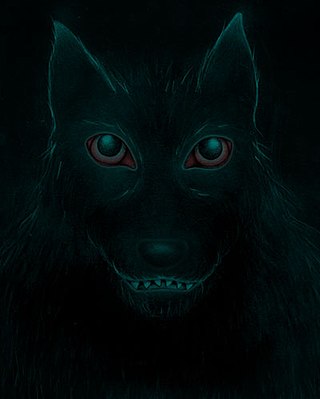
The Wild Hunt is a folklore motif occurring across various northern, western and eastern European cultures, appearing in the religions of the Germans, Celts, and Slavs. Wild Hunts typically involve a chase led by a mythological figure escorted by a ghostly or supernatural group of hunters engaged in pursuit. The leader of the hunt is often a named figure associated with Odin in Germanic legends, but may variously be a historical or legendary figure like Theodoric the Great, the Danish king Valdemar Atterdag, the dragon slayer Sigurd, the Welsh psychopomp Gwyn ap Nudd, biblical figures such as Herod, Cain, Gabriel, or the Devil, or an unidentified lost soul either male or female. The hunters are generally the souls of the dead or ghostly dogs, sometimes fairies, valkyries, or elves.

A Hand of Glory is the dried and pickled hand of a hanged man, often specified as being the left hand, or, if the person was hanged for murder, the hand that "did the deed."

In mythology, folklore and speculative fiction, shapeshifting is the ability to physically transform oneself through unnatural means. The idea of shapeshifting is in the oldest forms of totemism and shamanism, as well as the oldest existent literature and epic poems such as the Epic of Gilgamesh and the Iliad. The concept remains a common literary device in modern fantasy, children's literature and popular culture.

The púca, pucapwca, pooka, phouka, puck is a creature of Celtic, English, and Channel Islands folklore. Considered to be bringers both of good and bad fortune, they could help or hinder rural and marine communities. Púcaí can have dark or white fur or hair. The creatures were said to be shape-changers that could take the appearance of horses, goats, cats, dogs, and hares. They may also take a human form, which includes various animal features, such as ears or a tail.

In English folklore, Black Shuck, Old Shuck, Old Shock or simply Shuck is the name given to a ghostly black dog which is said to roam the coastline and countryside of East Anglia, one of many such black dogs recorded in folklore across the British Isles. Accounts of Black Shuck form part of the folklore of Norfolk, Suffolk, the Cambridgeshire Fens and Essex, and descriptions of the creature's appearance and nature vary considerably; it is sometimes recorded as an omen of death, but, in other instances, is described as companionable.

The Dullahan is a type of legendary creature in Irish folklore. He is depicted as a headless rider on a black horse, or as a coachman, who carries his own head. As it not widely attested in native sources, including no references to it on the extensive website of the Irish Folklore Commission Dúchas.ie, there is doubt as to whether the Dullahan was originally a part of the Irish oral tradition.

The Gytrash was a legendary shape-changer known in parts of the West Riding of Yorkshire. It was said to haunt lonely roads awaiting travelers. Appearing usually in the shape of animals, the Gytrash haunt solitary ways and lead people astray, but they can also be benevolent, guiding lost travelers to the right road. They are usually feared. The Gytrash is a shapechanging cousin of the Lincolnshire and Northamptonshire Shagfoal, of the Lancashire Skriker, of the Padfoot, also from the West Riding and of Barguest of much of the North Riding, Cumberland, Lincolnshire, County Durham and Northumberland.

Mujina is an old Japanese term primarily referring to the Japanese badger, but traditionally to the Japanese raccoon dog (tanuki), causing confusion. Adding to the confusion, it may also refer to the introduced masked palm civet, and in some regions badger-like animals or Japanese raccoon dog are also called mami.

A hellhound is a mythological hound that embodies a guardian or a servant of hell, the devil, or the underworld. Hellhounds occur in mythologies around the world, with the best-known examples being Cerberus from Greek mythology, Garmr from Norse mythology, the black dogs of English folklore, and the fairy hounds of Celtic mythology. Physical characteristics vary, but they are commonly black, anomalously overgrown, supernaturally strong, and often have red eyes or are accompanied by flames.

The church grim is a guardian spirit in English and Nordic folklore that oversees the welfare of a particular Christian church, and protects the churchyard from those who would profane and commit sacrilege against it. It often appears as a black dog but is known to take the form of other animals. In modern times, when black dogs are kept as pets in churches and their attached parsonages, these are called church Grims since they reside on and guard ecclesiastical property.
The baobhan sith is a female fairy in the folklore of the Scottish Highlands, though they also share certain characteristics in common with the succubus. They appear as beautiful women who seduce their victims before attacking them and killing them.

The black dog is a supernatural, spectral, or demonic hellhound originating from English folklore that has also been seen throughout Europe and the Americas. It is usually unnaturally large with glowing red or yellow eyes, is often connected with the Devil, and is sometimes an omen of death. It is sometimes associated with electrical storms, and also with crossroads, barrows, places of execution and ancient pathways.
The Moddey Dhoo is a phantom black dog in Manx folklore that reputedly haunted Peel Castle on the west coast of the Isle of Man. The Manx name Moddey Dhoo was transcribed as Mauthe Doog by an influential 18th-Century English-speaking folklore source, which led to a history of misspellings of the proper name.
Mythic humanoids are legendary, folkloric, or mythological creatures that are part human, or that resemble humans through appearance or character. Each culture has different mythical creatures that come from many different origins, and many of these creatures are humanoids. They are often able to talk and in many stories they guide the hero on their journey.

The Headless Horseman is an archetype of mythical figure that has appeared in folklore around Europe since the Middle Ages. The figures are traditionally depicted as riders upon horseback who are missing their heads. These myths have since inspired a number of stories and characters in popular culture, including The Legend of Sleepy Hollow.

The Barghest O' Whitby is an EP by My Dying Bride, released on 7 November 2011. It consists of a single, 27-minute track.

Cyberpunk 2077 is a 2020 action role-playing video game developed by CD Projekt Red, and published by CD Projekt, and based on Mike Pondsmith's Cyberpunk tabletop game series. The plot is set in the fictional metropolis of Night City, California, within the dystopian Cyberpunk universe. The player assumes the role of V, a mercenary who accidentally gets imbued with a cybernetic "bio-chip" containing an engram of legendary rockstar and terrorist Johnny Silverhand. As Johnny’s behavioral template and memories begin overwriting V’s own, the two must work together to separate from each other and save V's life.

CD Projekt S.A. is a Polish video game developer, publisher and distributor based in Warsaw, founded in May 1994 by Marcin Iwiński and Michał Kiciński. Iwiński and Kiciński were video game retailers before they founded the company, which initially acted as a distributor of foreign video games for the domestic market. The department responsible for developing original games, CD Projekt Red, best known for The Witcher series, was formed in 2002. In 2008, CD Projekt launched the digital distribution service Good Old Games, now known as GOG.com.
Prince Wolf is a Danish fairy tale collected by Svend Grundtvig in his book Danske Folkeaeventyr. It is related to the international cycle of the Animal as Bridegroom or The Search for the Lost Husband. Tales with similar motifs and elements are found across Denmark and Scandinavia.














